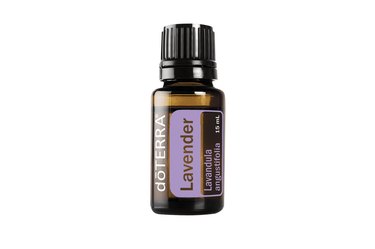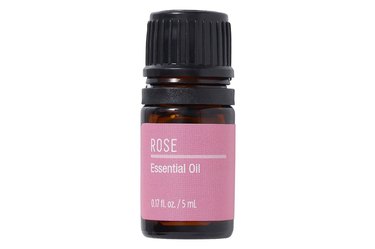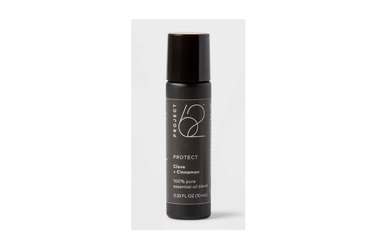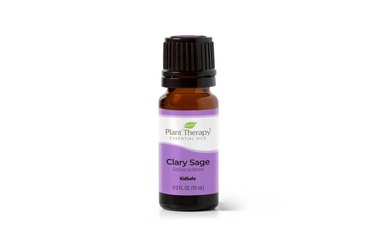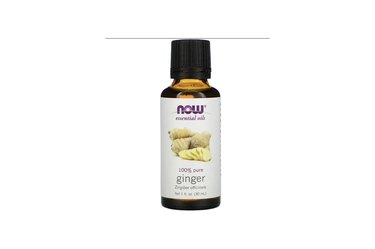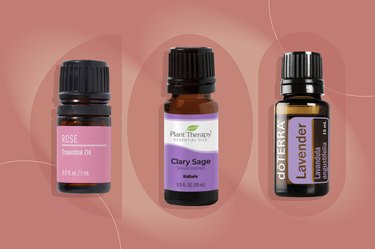
You're not imagining it — cramps absolutely suck. A whopping 85 percent of people who have periods experience menstrual cramps, according to a June 2019 survey of about 43,000 women in the American Journal of Obstetrics and Gynecology.
More shocking is how menstrual symptoms affect their day-to-day: Nearly 4 in 10 said they're forced to skip some daily tasks because of them.
Video of the Day
Video of the Day
If you get all crampy in the days leading up to your period and throughout your flow, you might not always want to take medication to ease the pain. If you're looking for something more natural, you may be considering essential oils, which, in this case, are often used by bathing in water spiked with the oil, combining them with a carrier oil and then massaging the mix onto your skin or by inhaling their aroma via diffuser.
But is it actually worth your time? The answer is maybe. Essential oils may work for you, but they may not.
"Patients ask me about various complementary and alternative remedies, including essential oils, every day," ob-gyn Taraneh Shirazian, MD, founder of Mommy Matters, tells LIVESTRONG.com. "However, we don't have a lot of data when it comes to essential oils," she says. (Much of the research uses small study samples and the available reviews and meta-analyses seem to rely on the same body of research.)
One review, published October 2021 in Revista Brasileira de Ginecologia e Obstetrica, found some evidence that aromatherapy triggers neurotransmitters that decrease the activity of your nervous system. (In other words: They help you chill out.) Certain scents may also prompt the release of endorphins and other natural pain-quashing chemicals.
Research in the Journal of Clinical Medicine from November 2018 that looked at 11 studies came to a similar conclusion: Aromatherapy massage was superior to regular massage when it came to reducing pain from cramping. (These two reviews relied on many of the same studies but came to similar conclusions.)
You can consider essential oils if you're looking for a natural remedy for menstrual cramps. Namely because, as Dr. Shirazian says, there's no major risk to using essential oils on your skin. "I always encourage patients to try things that we don't think are high-risk because there are many alternative practices that do help many patients, and essential oils may be one of them," she says.
Pain is a subjective experience, and you may find oils to be particularly soothing for your discomfort.
It's also worth trying minimum interventions to see if they are helpful to you. Even if it doesn't work, it gives you (and your doctor — be honest about what you're doing!) valuable information. At that point, you can try something else (like an over-the-counter pain reliever).
If more natural remedies and OTC pain meds still don't help relieve cramps, then your doctor may need to evaluate you for potential underlying conditions.
"Many people have a lot of pain during their cycles, and they think it's normal," Dr. Shirazian says. If that pain prevents you from doing daily activities or working, then you deserve to know what's going on and get the help you need.
That said, if you're interested in trying essential oils for PMS or menstrual cramping, here are five to consider:
1. Lavender
The scent of lavender — used often as a sleep aid — is strongly associated with feelings of relaxation. In an interesting, though small, July-August 2021 study in Holistic Nursing Practice, people who received massage with lavender oil following gynecologic surgery rated their pain lower 30 minutes post-massage compared to both placebo and control groups.
Various other studies have also singled out lavender essential oil massage as being specifically useful against menstrual pain, per a May 2017 meta-analysis in Complementary Therapies in Clinical Practice. Other research, from Complementary Therapies in Medicine in April 2014, found that inhaling the scent of lavender (diluted with sesame oil) decreased the sensation of crampiness better than sesame oil alone.
Lavender may, indeed, trigger you to feel as if you're in a spa-like environment (rather than laying on your couch in pain from cramps), Dr. Shirazian says. "This can create a relaxing and tranquil feeling that may decrease subjective feelings of pain," she explains.
Try These Lavender Essential Oils
- Doterra Lavender: Doterra.com; Price: $30.67 for 15 mL
- Now Lavender Oil: NowFoods.com; Price: $5.99 for 0.33 fl oz
- L’Occitane Lavender Essential Oil: LOccitane.com; Price: $14 for 5 mL
2. Rose
It might be tough to stop and smell the roses when you have cramps, but it may be worth it. The October 2021 review in Revista Brasileira de Ginecologia e Obstetrica specifically calls out rose oil for pain-relief potential.
Rose oil contains several aromatic compounds, such as geraniol, nerol and kaempferol, which have been shown in research to decrease menstrual pain better than a placebo. Other research has found that the combination of rose oil plus a non-steroidal anti-inflammatory (NSAID) was more effective in dialing down discomfort compared to a placebo and NSAID alone.
Try These Rose Essential Oils
- Plant Therapy Rose Absolute Essential Oil: PlantTherapy.com; Price: $29.95 for 5 mL
- Ulta Beauty Rose Essential Oil: Ulta.com; Price: $15 for 5 mL
- Edens Garden Rose Bergamot Essential Oil Blend: EdensGarden.com; Price: $15.95 for 5 mL
3. Cinnamon or Clove
It's time to get spicy — at least when it comes to your essential oils for PMS. April 2013 research in Evidence-Based Complementary and Alternative Medicine on about 100 nursing students found that using an essential oil blend of cinnamon, clove, rose and lavender (mixed in a base of almond oil) for seven days before their period lessened menstrual pain and bleeding more so than the placebo group, who used massage with almond oil only.
Both cinnamon and clove are warming spices, which is why this blend may be particularly potent against pain. In addition to lavender's soothing properties, clove may help rev circulation to lessen muscle aches, as well as help block pain, the researchers explain. Cinnamon, meanwhile, has been suggested to affect prostaglandin production, which is what causes uterine muscles to contract.
You may not be able to find this exact blend in stores, but you can experiment with different essential oils in this mix to see if they're especially helpful for you. There are numerous cinnamon and/or clove options out there. If you like the smell of them all combined, you can also make a mix at home on your own.
Try These Cinnamon or Clove Essential Oils
- Project 62 Clove + Cinnamon: Target.com; Price: $10 for 10 mL
- Thrive Market Cinnamon Leaf Essential Oil: ThriveMarket.com; Price: $5.99 for 15 mL
- Nature’s Fusions Clove Essential Oil: NaturesFusions.com; Price: $10 for 15 mL
4. Sage or Marjoram
Love an herbal scent? There's very limited evidence that a blend of oils with lavender, clary sage and marjoram massaged onto the lower abdomen throughout most of your cycle (from the end of your last period to the beginning of the next) can help with cramping. A group tried this for May 2012 research in the Journal of Obstetrics and Gynaecology Research and it decreased feelings of pain and slashed the duration of discomfort from 2.4 days to 1.8 days. (Another group, who used synthetic fragrance, also experienced pain relief.)
The study authors credit pain-relieving compounds in the blend, such as eucalyptol and caryophyllene.
Try These Sage or Marjoram Essential Oils
- Plant Therapy Clary Sage Essential Oil: PlantTherapy.com; Price: $10.95 for 10 mL
- NOW Essential Oils 100% Pure Marjoram: iHerb.com; Price: $12.04 for 30 mL
- Edens Garden Clary Sage Essential Oil: EdensGarden.com; Price: $11.95 for 10 mL
5. Peppermint or Ginger
Your period can be a drag, but peppermint can give you a bit of a lift.
Research from 2013 in the Journal of American Science looked at groups of young nursing students — one received abdominal massage with peppermint oils, while another got the same treatment with ginger oil and a control group had an almond oil massage. Those in the peppermint and ginger groups reported their pain reduced from moderate/severe to mild/none, as well as improved daily functioning.
Yet it was the peppermint group that also benefitted from a shorter duration of pain, as well as better mood, appetite and less diarrhea or constipation. The ginger group said they were less nauseated, dizzy, tired and headach-y. (The two oils are are believed to have pain- and muscle-calming properties.)
The researchers note that depending on your symptoms, you may opt for one oil over the other.
Try These Peppermint and Ginger Essential Oils
- Nature’s Truth Peppermint Aromatherapy Essential Oil: Target.com; Price: $6.99 for 15 mL
- Young Living Peppermint Essential Oil: YoungLiving.com; Price: $30.26 for 15 mL
- NOW Essential Oils 100% Pure Ginger: iHerb.com; Price: $7.31 for 30 mL
What to Know Before You Buy
1. Dilution
One of the most important things to remember about using essential oils — if you're going to rub them on your skin — is to dilute them in a carrier oil. Although essential oils are billed as "natural," using them straight on your skin can cause irritation, Nava Greenfield, MD, a dermatologist with Schweiger Dermatology in New York City, tells LIVESTRONG.com.
She recommends using a 3 to 5 percent dilution. That means adding 20 to 30 drops of essential oil per six teaspoons of carrier oil. Carrier oils may include:
- Mineral oil
- Almond oil
- Coconut oil
2. Possible Reactions
Of course, your skin can still react even if you've been using a certain essential oil topically for a while without problem, Dr. Greenfield says. This reaction may look scaley and red and may also itch. You don't need to do a patch test before using an oil, but if your skin is typically sensitive, it can be a smart idea. Do this by applying a small amount to the inside of your forearm twice a day for two weeks. No reaction? You're good to rub it elsewhere.
If you notice that you break out into a rash after starting an essential oil, stop using it. It may take a couple weeks for redness or scaliness to go away, Dr. Greenfield says.
3. Purity
When looking for an essential oil, make sure what you purchase is labeled as "pure," and ones that contain just the essential oil on the ingredients list. (Roll-on products will already be mixed with a carrier oil. That's OK, just make sure to read the ingredients to know what's in your formula.)
4. Price
You'll find these in a wide range of price points. It's not necessary to buy one that's really expensive; essential oils are available inexpensively from reputable companies.
Other Treatments to Try
Beyond essential oils, here's what you can use for a more comfortable period:
1. Over-the-Counter Medication
Non-steroidal anti-inflammatory medications (NSAIDs) such as ibuprofen or naproxen have been found to be over four times more successful in relieving pain compared to a placebo, according to a 2015 review in the Cochrane Database of Systematic Reviews. One caveat: Popping an NSAID also increases the risk of side effects, such as GI problems.
If taking an NSAID, Dr. Shirazian recommends "preloading" by popping the meds one day before your expected period. "This minimizes pain receptors and delivers the best benefit. It's hard to break the pain cycle once it starts," she says.
2. Heating Pads
"Heat pads are great, especially if you have low back cramps during your period," Dr. Shirazian says.
Position the pad where it hurts most, either on your abdomen or lower back.
3. Exercise
It might be the last thing you want to do, but get up and out the door for speed walking, a run or a bike ride. "Exercise is wonderful for releasing natural endorphins," Dr. Shirazian says.
If possible, try to work out when you wake up. When done in the morning, you'll release a lot of stress and pain-relieving hormones. She recommends something cardio-focused that will increase your heart rate and make you sweat to really get those endorphins flowing.
Related Reading
- Revista Brasileira de Ginecologia e Obstetricia: “The Effect of Aromatherapy Alone or in Combination with Massage on Dysmenorrhea: A Systematic Review and Meta-analysis.”
- Journal of Clinical Medicine: “Aromatherapy for Managing Pain in Primary Dysmenorrhea: A Systematic Review of Randomized, Placebo-Controlled Trials.”
- Complementary Therapies in Clinical Practice. “Effect of aromatherapy massage on pain in primary dysmenorrhea: A meta-analysis.”
- American Journal of Obstetrics and Gynecology: “The impact of menstrual symptoms on everyday life: a survey among 42,879 women.”
- Holistic Nursing Practice: “Effect of Massage With Lavender Oil on Postoperative Pain Level of Patients Who Underwent Gynecologic Surgery: A Randomized, Placebo-Controlled Study.”
- Complementary Therapies in Medicine: “Effect of lavender inhalation on the symptoms of primary dysmenorrhea and the amount of menstrual bleeding: A randomized clinical trial.”
- Journal of Obstetrics and Gynaecology Research: “Pain relief assessment by aromatic essential oil massage on outpatients with primary dysmenorrhea: a randomized, double-blind clinical trial.”
- Journal of American Science: “Effect of Aromatherapy Abdominal Massage using Peppermint Versus Ginger oils on Primary Dysmennorrhea among Adolescent Girls.”
- Evidence-Based Complementary and Alternative Medicine: “The Effect of Aromatherapy Abdominal Massage on Alleviating Menstrual Pain in Nursing Students: A Prospective Randomized Cross-Over Study.”
- Cochrane Database of Systematic Reviews: “Nonsteroidal anti-inflammatory drugs for dysmenorrhoea.”
Is this an emergency? If you are experiencing serious medical symptoms, please see the National Library of Medicine’s list of signs you need emergency medical attention or call 911.
